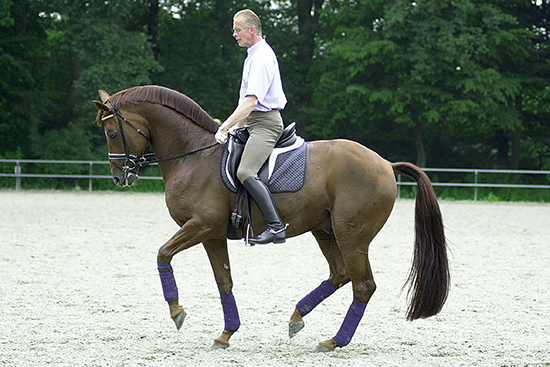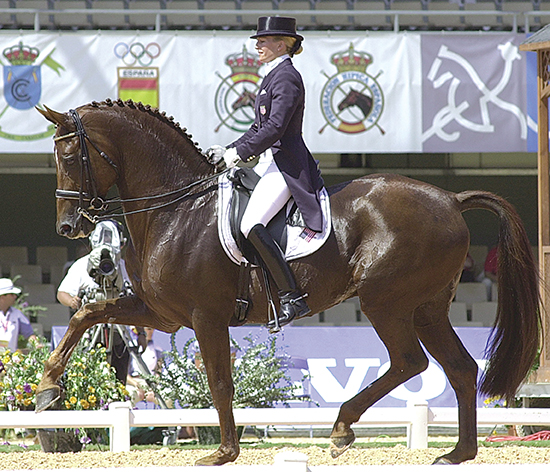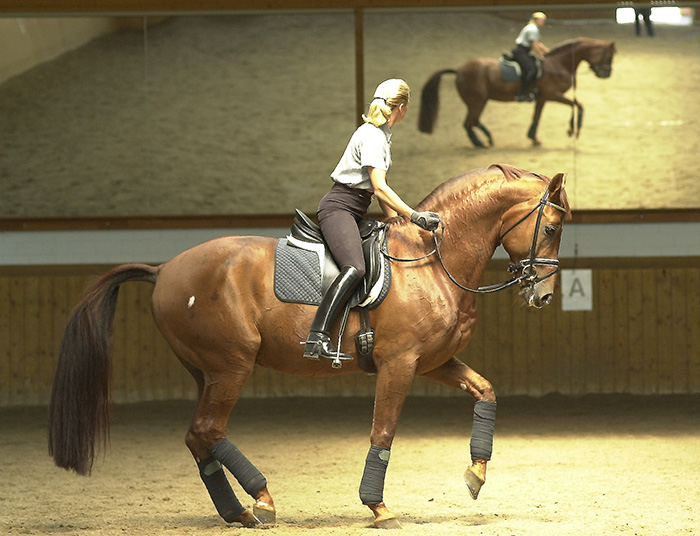
If Ernst Hoyos is a genius, Lisa Wilcox is an inspiration. Living breathing proof that no matter where you are born if you have the talent, the drive and the capacity to hang in there, you can make it in the world of international dressage.
Reli practising relaxed piaffe at home with Lisa
But then again grit and determination have been pretty well a Lisa Wilcox thing since her dad handed her that first horse – ‘green broke’ but complete with a bridle and a rope around its girth to hang on to!
Lisa is also warm, friendly and great fun to work with…
We left Ernst and Lisa last month working in the indoor school. For our second and third days, the German sun decided to shine, and it was possible to work in the huge outdoor arena at the Gestüt Vorwerk. This is an additional test for the young stallions because there are mares and foals going past on their way to the breeding clinic all the time. As Lisa explains, it makes them pretty well mannered when they get to a horse show.
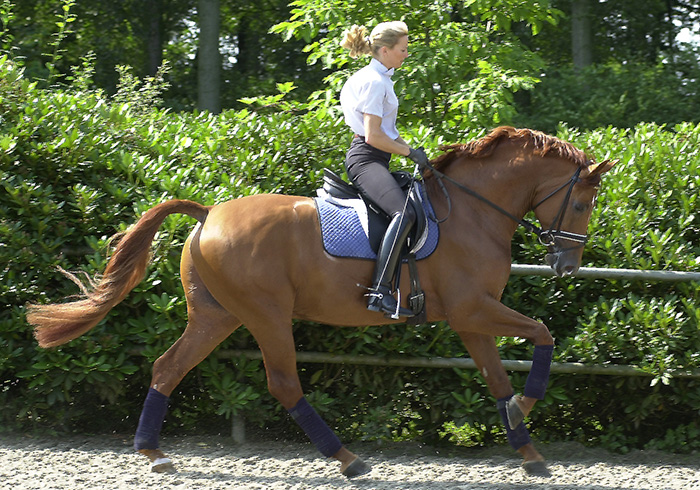
In the outdoor arena, Lisa starts again with Raoul, once more asking him to be very submissive in front while maintain max activity behind. Lisa is working on the canter, and Raoul is now strong enough to handle the canter walk transitions with ease, and looks ever so balanced as he goes through a series of counter canter circles. Just how useful the counter canter is, is shown when Lisa takes off for one enormous straight canter down that incredibly long long side, and every single stride is deadly straight.
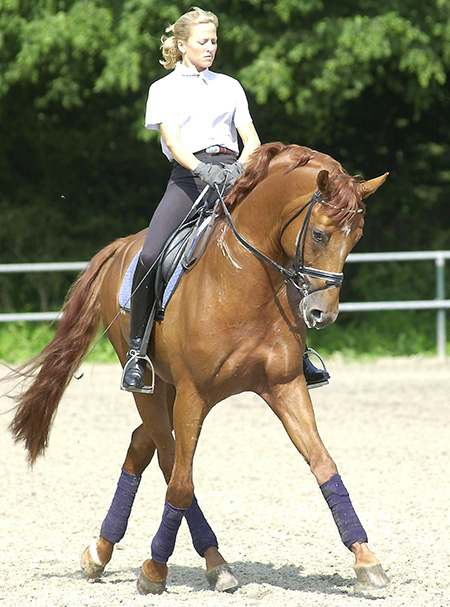
Now she is really asking the young stallion to bend, really tight angles for the half pass and an extreme travers, showing four tracks in the lateral work, again with total engagement but never ever rushing the horse, and when the big trot comes it comes slowly, smoothly, out of the engagement, and what a trot it is, and so even.
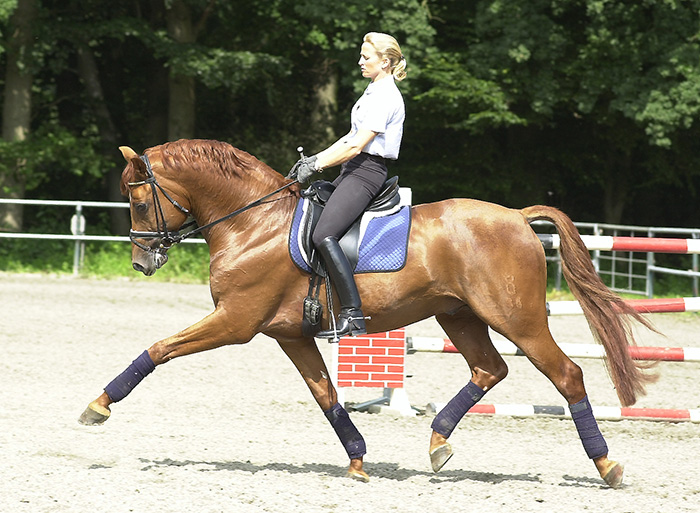
“He has to be even in the hand for that, unevenness in the trot comes from an uneven connection in the hand.”
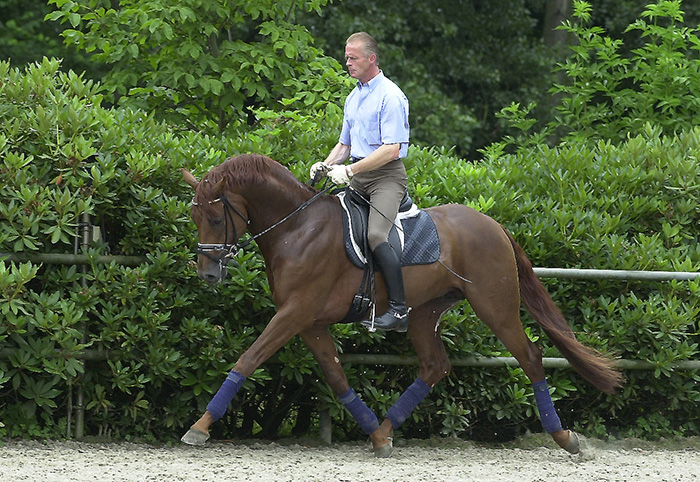
Usually when you see a trot as big as this it looks a bit fragile, as if it has come from tension, but this is sheer power. Ernst demonstrates the technique later on another exciting youngster, Relevant’s three-year-old little (full) brother, Revan. I remark to Ernst that he has waited ‘til right at the end of the working session, and let the extension come as a reward rather than out of pressure – okay we’ve done the hard work now you can have a bit of a stretch…
“That is correct, in his head he was comfortable and he wanted to move forward. If I asked this too early in the work, then he would have started to run, but once he started carrying himself, then it was a natural thing to let the energy go, and the horse developed the trot, and I just played with it so the horse felt good about the trot rather than cranky with it.”
Ernst teaches that you can help the horse go forward by loosening your leg. It is almost a paradox: to make the horse go forward, take off the leg, loosen the leg. Most books say to make the horse go forward, squeeze with your legs…
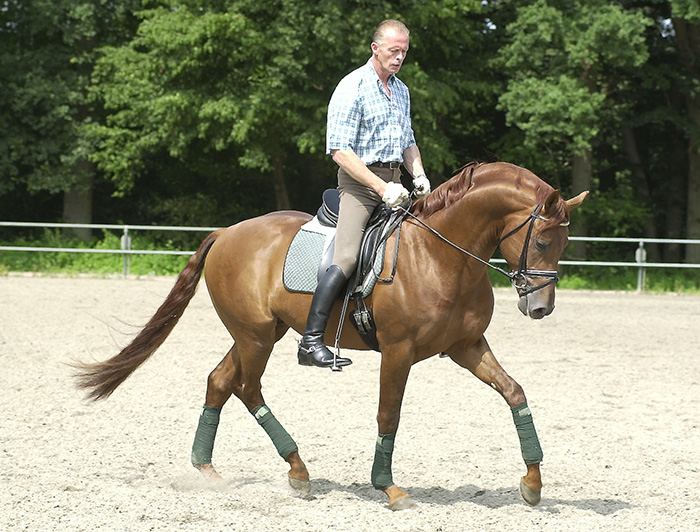
Lisa explains: “It is the natural instinct of a horse, when you press down on him, he is going to tighten himself up. If you had someone sitting on top of you and squeezing your ribs, you would not be in a position to take off and run as fast as you could. If someone sits loosely, lightly, then you can move. It is the natural instinct of the horse – aaah – he opens up. You squeeze, and he gets tight. We exaggerate it, and the horse also thinks you are coming with the leg. It can be that you take your leg away, so you can come very quickly with your leg. The rider opens up, the horse thinks, oh she is coming, and so they go forward. You are teaching this horse to react to the lightest of aids. This is the level we need to get to where no one sees what you do to cause the reaction.”
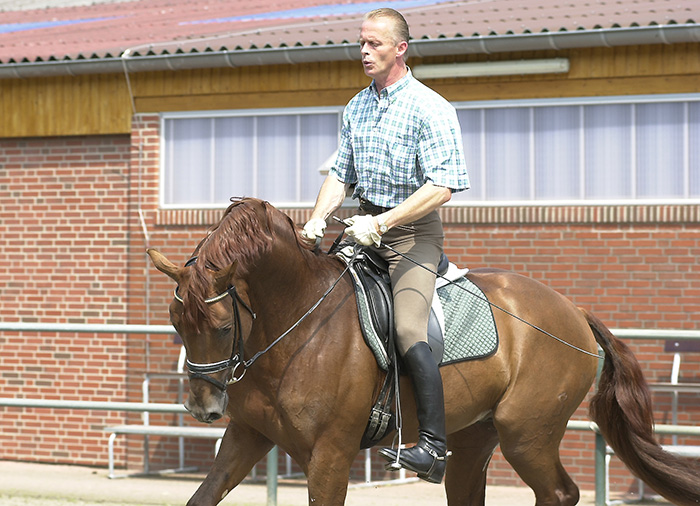
Ernst amplifies the point: “I also ride with my seat and my legs, but the mistake a lot of riders make is that they clamp down with their upper leg, and that brings the horse back, but they don’t realise this, and then they get going with their lower leg to get a forward reaction.”
“They don’t realise that they are asking two opposite things. I also have a nice contact in the forward, but the pressure I make, I have also got to let out again. This is the ever-changing task of maintaining the energy – it goes back and forth over the back, this is the bridge, and the energy is going from the hind end and the hocks over the back through the neck and into the mouth, and then back again. You are just maintaining the energy. If you brace with dead hands, then the energy flows out the back. If you sit and send the horse forward and throw it away, then the horse falls on the forehand. You have to have the horse’s level in your mind, and you have to make it as easy for that particular horse as possible. The pressure one horse needs, the other horse does not. Then the horse will work for the rider – but every rider has to be individually sensitive to the particular horse he is riding at the time. The theory doesn’t change but the pressure changes.
And a lot of that forward charge comes from the stomach?
“A rider needs to learn to breathe from the lower stomach and everything will relax – the most important thing is that the shoulders of the rider relax.
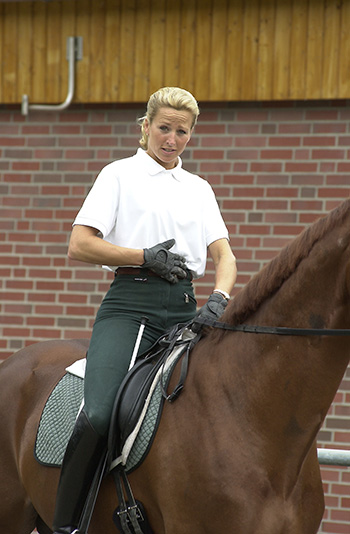
Most of the riders ride with their upper body very stiff – especially their shoulders. If the stomach is in balance and in the position it should be, the shoulders are allowed to relax, and should relax. You need to be loose in your shoulders. As long as the rider is breathing in the upper body he is going to be too tight, too cramped to get the horse to go forward from a relaxed seat. The rider learns to breathe in the lower stomach and everything will relax. The weight will come into the saddle and the horse moves away from the aid of the weight. But if a rider cramps in the upper body, he cramps everywhere and is effectively unable to ride his horse.”
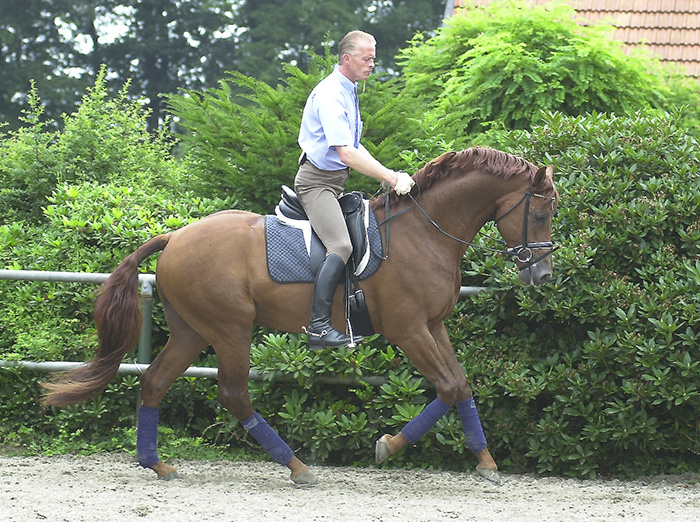
The other interesting thing about Ernst’s position on the horse, is the way he rides with his elbows slightly away from his side:
“I want to help the young horses with their straightness through the wide hand carriage making a channel into the hocks, when you get too narrow with your hands, then you don’t have the hocks any more. I try to make the horse round – if there is tension then the energy goes up and outwards – we are trying to make it stay low and direct in the channel. By staying a little wide I help the horse to balance. When I am correcting the horse – also the older horses – then my hands are wider. It is all about balance. When we are riding nicely, then I go back to the classical position – but when you are correcting it is better to go wide and help the horse find his balance more quickly and easily as the correction is happening.”
Watching you ride, your feet are incredibly still and the angle to the horse is always the same…
“The rider has to be disciplined with the body – the rider must be able to hold the body, the most important thing is that we stay still, and that the rider should be able to hold his position. We should be able to hold our bodies in this light position, it doesn’t matter what the horse is doing the rider should be able to stay in the centre of balance and hold his balance independent of what the horse is doing. We must learn to work independently of the horse – you can’t be holding onto the horse’s mouth to keep yourself in position. It is important that we develop our own body balance.”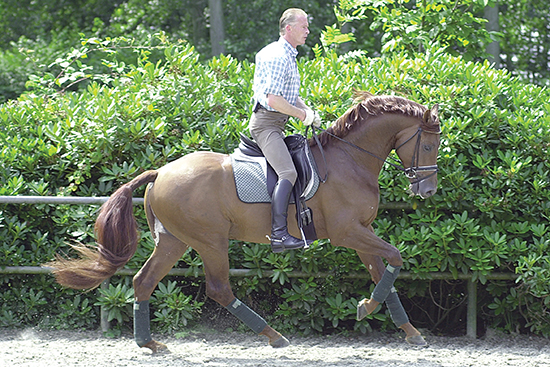
Ernst comments: “Again perfect balance and showing how the rider supports a three-year-old in the canter. The rider is supporting the horse by sitting lightly, because one should be very careful with the backs of the young horses.”
As we drool about Revan, Lisa points out that like all the Rubinstein line, he will take time to develop his full-potential in the trot:
“The Rubinsteins are known to develop their trot at the age of five or six, they are not generally horses for material classes. Relevant had even less trot than his little brother at the same age – the trot develops out of consistent training six days a week. Day in day out the horses are confronted with the same information. My goal is to ride as similar to Ernst as possible. I am working every day on my seat, in another 30 years I’ll have it. Horses must not be confused, they must be confronted with the same information, you mustn’t frustrate them. That’s why our horses progress, consistent work every day.”
And no grooms to walk the horses in or cool the horses down?
“No we do it ourselves. The walk is an extremely important gait, and you can so easily screw it up. I’d rather ride them myself and keep control of the walk.”
“We have a girl and she takes some of the horses out for their hacks on the Saturday but only three people ever sit on these horses, and I am very particular about that. I like to go out with them on their hacks too, because that’s when they learn to trust you. We run into deer and we run into pheasants, all sorts of wild life, and they learn to trust me. We are a partnership, and when it gets to the nitty gritty and they start to stress, they say ‘okay it’s Lisa’ and they are with me.”
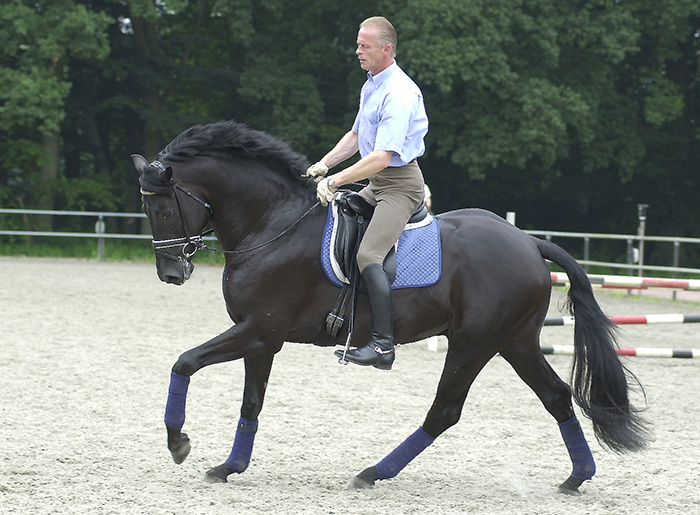
“Showing full potential to canter and step underneath the centre of gravity, perfectly. Very relaxed, inside rein giving – a picture book illustration of the inside and outside hands, the horses is stepping under, bending offering everything he can offer.”
Ernst is riding a really brilliant baby now but until the three-year-old passes his performance test he is only known as black colt by Rubinstein from an Ex Libris mare. I suggest they call him Rhapsody because when he gets going he is like a piece of music, and when he spooks on me sitting in the corner, he suddenly grows a couple of hands and up comes his neck and we have a preview of what the future holds for the horse. Once again, none of the work is ‘different’, it is just all so focussed – the rider’s response so swift and sure, leaving the horse in no doubt about what is right or wrong. Every step is a learning experience for the horse.
“Because our training is consistent, the horses are comfortable,” says Lisa, “We don’t want our horses to ever be stressed. But we have to be careful because we are working with stallions – breeding stallions – and Ernst says ‘don’t ever put a stallion into a situation where you show him he is stronger than you. Wait – don’t put him in that situation where he learns what you don’t want.”
Over the three days, the star of the working sessions has been Relevant. On the first two days, Lisa rides him, on the third, it is Ernst in the saddle. This work is critical because we are into the final month before the World Championships at Jerez, and at Aachen, Relevant did something he had never done before with Lisa in the saddle – he freaked out and tried to get away in the piaffe. It was a problem he had shown with his previous rider, but Lisa had not had to deal with it before. She actually worked on it at Aachen, using the freedom of the freestyle to ask for the piaffe in a no pressure situation, and the impetus of a piaffe pirouette to take some of the tension out of the movement. At home, both she and Ernst are working hard to reinforce the message, riding the horse even in the most collected of movements, in a forward seat, just toying with the piaffe but letting it come in seemingly endless waves…
Ernst and Relevant at home: This is one of the first times we have asked for the piaffe in the work that day. We are asking the horse with very little aids, it is coming mostly from him, getting him to relax and want to go over his back, deep, long and low basically. He isn’t long but I would like him to stretch and go over his back in the piaffe, maintaining the hind end but with very little direct aids from me. In the very beginning playing softly, letting it come from him. I’m not asking, I’m not pressuring, no direct pressure on the mouth, we are playing basically, like it is just for fun.
And interestingly, Lisa starts early in the training session into piaffe with Relevant:
“I’m just playing with him,” Lisa says, “give contact, let go, softening in the piaffe itself so he’ll relax.”
Relax he does, and is into a series of magnificent movements – half pass, the angle so steep, the horse so correct, breath-taking passage and out into spine tingling extended trot, a canter that motors down the track then shortens almost on the spot, keeping the rhythm so perfectly through the pirouette, and out and into a series of effortless one times changes. What a privilege it is just to sit beside the arena and watch. For me, this is modern competition dressage at its best, and I mention to Ernst that it has always been my impression that in the Spanish School they feel dressage has been going downhill since about 1750, and what we see in the competition arena is not pure… do you feel this way about competition dressage, do you like to watch the modern dressage horses?
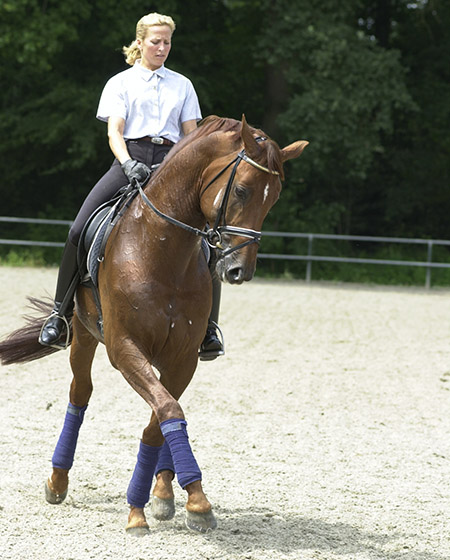
Ernst: Correct in the half pass, Relevant is correctly on the aids. Out of riding half pass with extreme bend and angle the horses will have it lighter, easier, in the test. Now they ask for the double half pass and that is extremely difficult, for the horse to bend its body and maintain a rhythm – how often do you see this movement performed well?
“The competition dressage world looks critically at what the Spanish Riding School does, and the Spanish School looks critically at what competition dressage does. The Spanish School is 430 years old and they try to keep their line alive, but in general in the Spanish Riding School the level has gone up, the same as the level in competition dressage has gone up. Look at the dressage sport twenty years ago, and look at it now, the quality is so much better. Look at Schultheis twenty years ago and the horses they had, then look at the horses of today. The riders of twenty years ago couldn’t win a class today. The standard has changed and the quality improved.”
“The class and the preciseness of every movement has been perfected.”
Are you glad you came out of the museum?
Ernst laughs a lot before answering the question.
“My interest lies with the sport of dressage, of course I am still interested in the Spanish School but now I am concentrating on the sport of dressage. This is what I am interested in…”
And for that we can be truly grateful.
Relevant and Lisa at the WEG in 2002, and some more at home pics

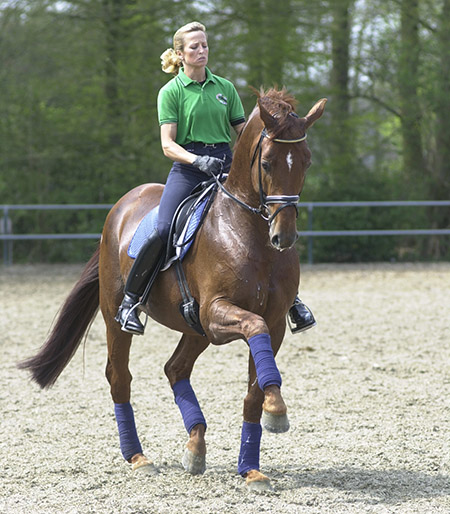
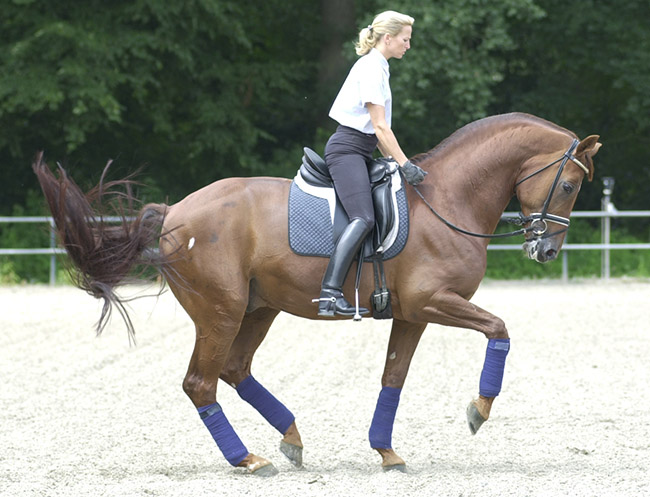
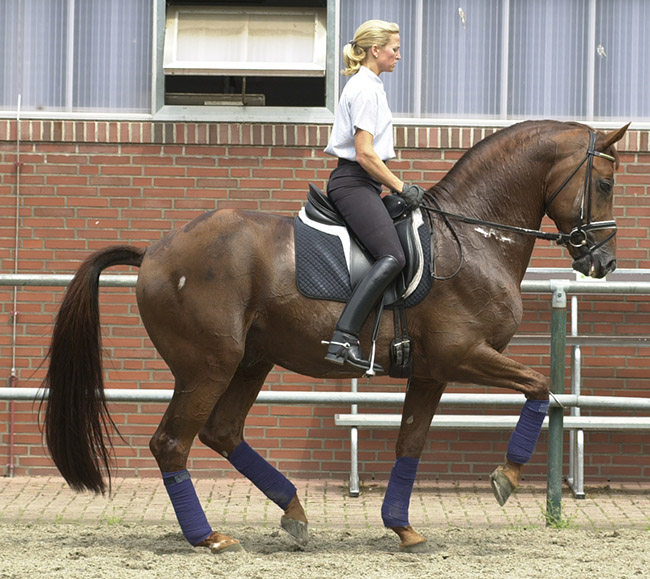
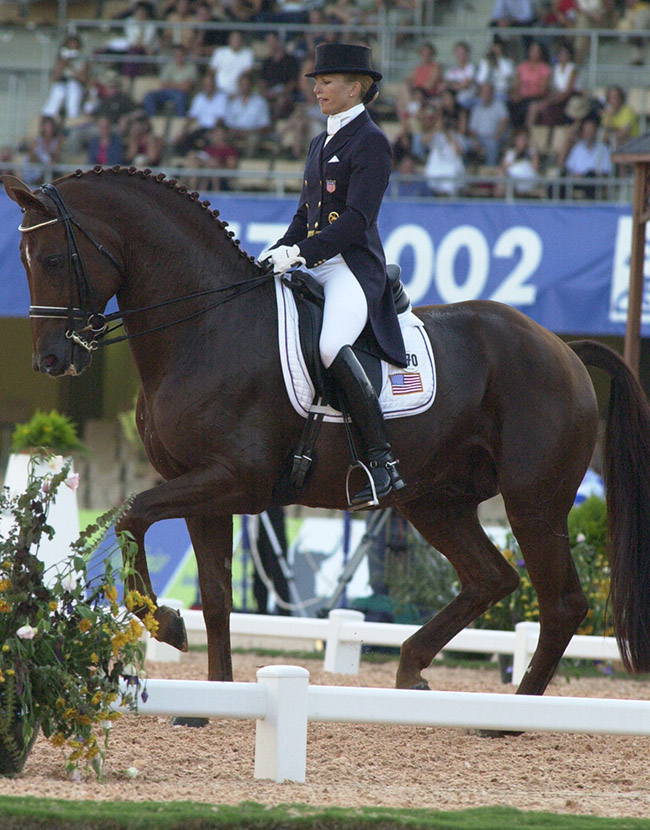
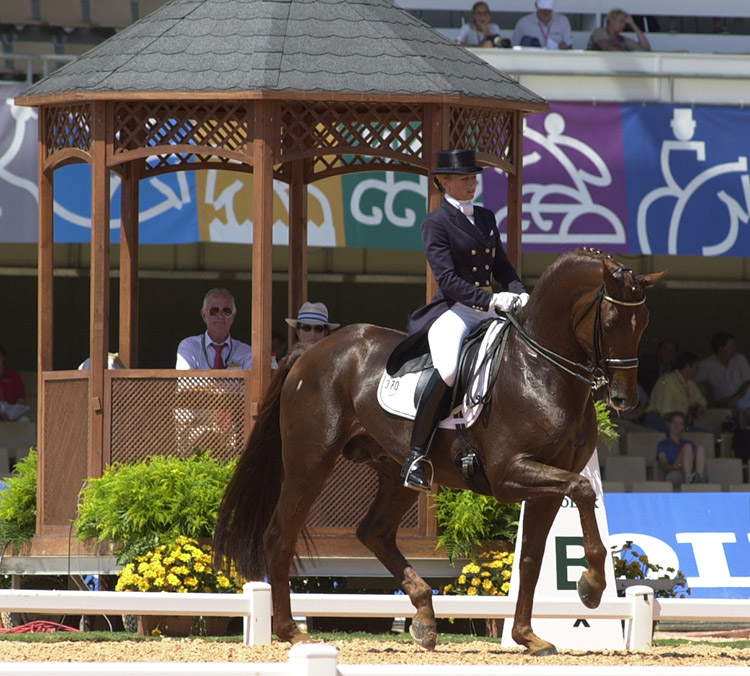
When we did the story twelve months ago, here you were in solitary splendour in your indoor school, not wanting anyone else around, concentrating all by yourself on ten horses a day – now it is a bit different in the hall?
“But it is a nice difference, it is nice to have someone of Ernst’s quality to look at. There I can always learn, you can learn with your eyes, you can learn with your ears, every moment is a learning process. What I was saying last time was if it was someone else conflicting with my ideas and ways, then I don’t want it around me in my private working place. Then I am a little bit stubborn – but this is enhancing the working place.”
“I have the feeling that I have the tip of the iceberg, and I am trying to learn everything, to absorb everything that Ernst has to offer.”
It’s not hard living with your teacher?
“Not at all, and I think we have done it in quite a clever way, he is not here the entire day, then I have the possibility to be free to think and be creative on my own, in the frame of our working context. I’m not jumping out doing anything wild, but I am able to think for myself and learn. That’s the kind of learner I am. I like to get the information and apply it. I have a couple of days, then he comes back and sees how I have applied the information, how I interpreted the information with the horses. Ernst is here until two o’clock. He goes and I finish the rest of the horses and think about things that I have to do.”
“When he is at Ulla’s that is a break in the sense that I can work on things that needed work on, that had to be corrected. I often do a lot of my own seat corrections then, it is a good time for me to really work on my seat for three days. I’ve got a 1000 things going on in my head, and he would just the thousand and oneth thing in my head. Then he comes back after three days, okay let’s see if I have improved? What has he got to say? Nothing! Aaah!! No, that’s what makes it so positive because I have an immense respect for him. If I didn’t have that respect then maybe that would be too many hours a day together. At the same time he respects me, and in a learning situation he doesn’t belittle – he is very careful with the words he uses to correct me, and that is of course very motivating and it is constructive, he can be very strict but it is a constructive criticism.”
And at a horse show, do you draw on him?
“Because of the way it has been, I can also relax when he is not there. I feel really good when he is there, you just feel like the picture is complete, the pie is filled, there are no pieces missing when he and Ferdinand are there. People ask do you have any lucky things that you must take to a horse show? Well, there is Ferdinand the groom, and Ernst at the big international horse shows. Ernst couldn’t always be there so that trained me to be able to think and work without him, it’s very good. It frees you up, you know you can do it without him because you’ve done it before. But when he is there he gives you the fine touches just before, things to think about when you go into the test, when you are in this corner do this, he gives me things, and then I go in with my plan. I’ve done this before when I was on my own, but he can do it perfectly. He might see things that I wouldn’t notice preparing by myself, and he just brings that snap into it, so I didn’t ride a half pass seven, he showed me something real quick just before I rode in, so I rode an eight.”
“This information I download – this is the challenging stuff for me, I can get excited just talking about it, because I want to challenge myself to make it better than it was last time. I remember all my mistakes, where I had them, and what I am going to do to correct them. You challenge yourself to make it better…”
This article first appeared in the December 2002 issue of THM.
Want to breed a Grand Prix star? Consider Sir Donnerhall available from International Horse Breeders: www.ihb.com.au
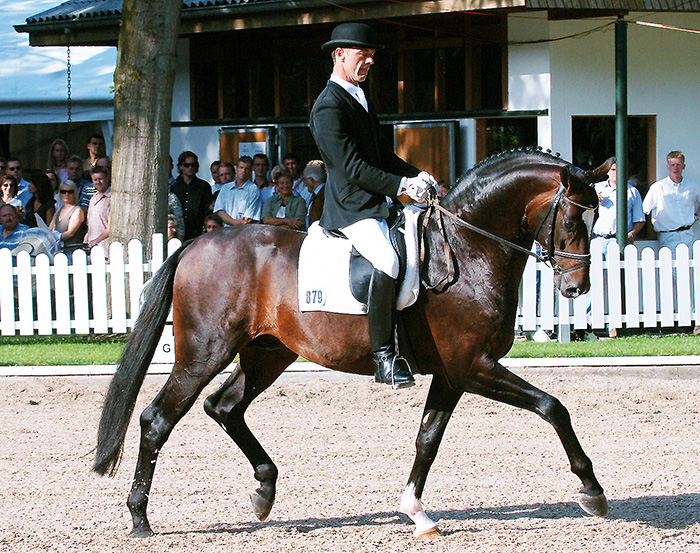
For more articles with Lisa and Ernst:


